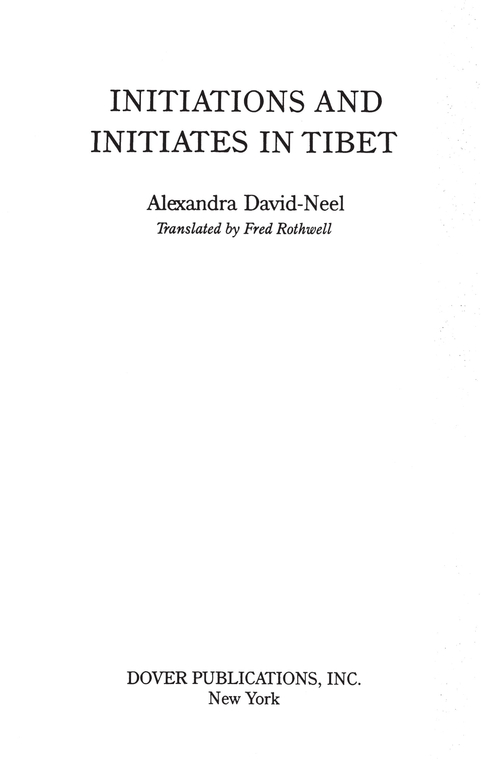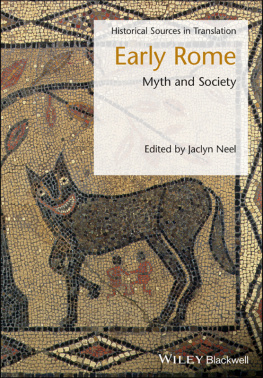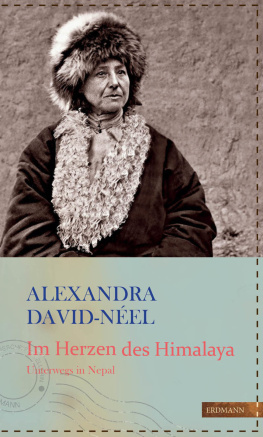Alexandra David-Neel - Initiations and Initiates in Tibet
Here you can read online Alexandra David-Neel - Initiations and Initiates in Tibet full text of the book (entire story) in english for free. Download pdf and epub, get meaning, cover and reviews about this ebook. year: 2012, publisher: Dover Publications, genre: Religion. Description of the work, (preface) as well as reviews are available. Best literature library LitArk.com created for fans of good reading and offers a wide selection of genres:
Romance novel
Science fiction
Adventure
Detective
Science
History
Home and family
Prose
Art
Politics
Computer
Non-fiction
Religion
Business
Children
Humor
Choose a favorite category and find really read worthwhile books. Enjoy immersion in the world of imagination, feel the emotions of the characters or learn something new for yourself, make an fascinating discovery.

- Book:Initiations and Initiates in Tibet
- Author:
- Publisher:Dover Publications
- Genre:
- Year:2012
- Rating:3 / 5
- Favourites:Add to favourites
- Your mark:
- 60
- 1
- 2
- 3
- 4
- 5
Initiations and Initiates in Tibet: summary, description and annotation
We offer to read an annotation, description, summary or preface (depends on what the author of the book "Initiations and Initiates in Tibet" wrote himself). If you haven't found the necessary information about the book — write in the comments, we will try to find it.
Initiations and Initiates in Tibet — read online for free the complete book (whole text) full work
Below is the text of the book, divided by pages. System saving the place of the last page read, allows you to conveniently read the book "Initiations and Initiates in Tibet" online for free, without having to search again every time where you left off. Put a bookmark, and you can go to the page where you finished reading at any time.
Font size:
Interval:
Bookmark:

This Dover edition, first published in 1993, is an unabridged, unaltered republication of the work first published by Rider & Co., London, 1931.
Library of Congress Cataloging-in-Publication Data
David-Neel, Alexandra, 18881969.
[Initiations lamaques. English]
Initiations and initiates in Tibet / Alexandra David-Neel : translated by Fred Rothwell.Dover ed.
p. cm.
Originally published: London : Rider, 1931.
9780486171272
1. Lamaism. 2. Initiation ritesReligious aspectsLamaism. 3. Spiritual life (Lamaism) I. Title.
BQ7602.D3813 1993
294.3923dc20
93-3372
CIP
Manufactured in the United States by Courier Corporation
27579504
www.doverpublications.com
T HE object of the present work is to supply those interested in the manifestations of Oriental spirituality with definite information regarding the nature of the Lamaic rites of initiation and the teachings given to the initiates, both during and subsequent to these ceremonies.
Needless to say, this subject cannot be treated exhaustively in so small a book. Besides, to enter into it fully, one must be familiar with certain theories of Mahyna Buddhism and Hindu Tantrism which are found to underlie most of the manifestations of Lamaic mysticism. The method in which these theories are conceived, amalgamated, and infused with elements of non-Aryan origin by the metaphysicians and anchorities of the Land of Snow, may furnish material for another work. All the same, the present volume will suffice to throw light upon one particular aspect, hitherto unknown to foreigners, of the religious life of the Tibetans.
Initiations and Initiates in Tibet forms a complete whole. However, I think I ought to recommend that it be read concurrently with my previous book : With Mystics and Magicians in Tibet, especially with the parts of that book which deal with the masters of mysticism, with their disciples and the methods of psychic training which they practise.
In contradistinction to the rule I had imposed upon myself in previous books, so that the text might not be unduly burdened, I have thought it prudent in the present book to give the orthography of most of the Tibetan terms as well as their pronunciation in the classic dialect of Lhassa. In some cases I have also given the Sanskrit equivalents of the Tibetan words. Frequently these latter will be better understood by readers who have met with them in works on Buddhism.
The Tibetan alphabet has a greater number of letters than the English ; to obviate the difficulties arising therefrom, Orientalists use certain conventional signs which they add to the letters of our alphabet when transposing a Tibetan text. This technical point, indispensable in other connections, here seems to me superfluous. It would fatigue to no purpose the eyesight of the reader, whose object it is to obtain information about the beliefs and practices of the Tibetans,not to learn their language. Those who already have an adequate knowledge of this latter will be quick to discern which of the Tibetan ch or s letters appear in the words they meet with; they will also know that the same Tibetan letter has for its equivalent w or b, etc., as the case may be.
ALEXANDRA DAVID-NEEL.
T O present to Westerners a perfectly clear and complete idea of the mysticism of the Tibetans is almost impossible. There is a wide gulf between the various religious and philosophical conceptions which they accept and those which serve as basis for the meditations of the ascetics of the Land of Snow. The very word mysticism, which I have used in a previous book and which I shall continue to use in this because I can find none better, must be understood, when dealing with Tibet, in a sense altogether different from the one we are accustomed to give it.
In the West, a mystic is a devout person,of a very superior type, granted, but always essentially a believer, the worshipper of a God.
On the contrary, the Tibetan mystic will probably be regarded by many Occidentals as an atheist. If we call him by such a name, however, we must guard against attributing to the term those feelings and ideas which it connotes in Western lands.
In countries under Christian influence the atheist, for centuries past, has been a rare exception, a kind of demoniacal character appearing in the flock of faithful believers. Even in these days he appears before the imagination of many as a rebel confronting Faith and Religion in a theatrical attitude of denial and challenge. There is nothing like this in Tibet where the idea of a supreme personal God has never held sway.
Among the numerous deities in the Lamaistic pantheon, there is not one that occupies the rle of an eternal omnipotent Being, the creator of the world. These deities are regarded as belonging to one of the six species of conscious beings recognised by popular belief. The abodes assigned to them are not always situated outside of our earth. Besides, when their habitual sojourn is allocated to other regions of space, these latter, so the Tibetans believe, are sufficiently near the earth to enable the gods to intervene at every turn. And so prudence enjoins one to live on neighbourly terms with the less important of these gods, to enlist the favour of the more powerful and to receive clemency or neutrality from those of evil disposition, even to resist them.
This religion, compounded of an exchange of good services, testimonies of respect, and a lion-tamers cunning, has nothing in common with the love that inflames certain Christian saints, still less with the passionate transportsso promptly degenerating into sensualityof certain bhaktas of India.
Sprung from such an environment, dominating it though retaining the impression it has made upon his nature, the Tibetan contemplative is giving way to no sentimental impulse when he leaves the society of men and withdraws to the desert. Still less does he imagine that he is doing anything in the nature of a sacrifice.
In contradistinction to the Occidental who frequently enters the cloister after doing violence to his deepest affections, with tear-stained face painfully tearing himself away from what he still designates as the good things of this world, the Tibetan ascetic, like the Hindu sannysin , envisages renunciation as a happy deliverance.
Buddhist writings contain many passages descriptive of this state of mind:
Home life is strict slavery, freedom consists in leaving home.
In the eyes of the Tathgata, the splendour of a king is no more than spittle or a speck of dust.
Full of charms are the lonely woods. Those who are freed delight in things that do not attract the populace.
No rapture awaits the sober thinker in his hermitage, his hut or cave, amid the immensity of Tibetan solitudes. Ecstasy, however, will be his for him to plunge himself therein. What will keep him in a state of attentive immobility day after day, month after month, and year after year, will be the contemplation of the working of his thought in self-analysis, effacing its own functionings according as they are discovered to be untrue, until the time comes when reasoning ceases because it has been replaced by direct perception.
Then, the storms raised by thought-creating theories and speculations having calmed down, the ocean of the mind becomes tranquil and smooth, without a single ripple disturbing its surface. In this faultlessly smooth mirror things are reflected without their image becoming distortedand this is the starting-point of a series of states which originate neither in ordinary consciousness nor in unconsciousness. This is the entrance into a sphere different from that in which we habitually move; hence, after making a certain number of reservations as to the meaning of the term, we may speak of Tibetan mysticism.
Font size:
Interval:
Bookmark:
Similar books «Initiations and Initiates in Tibet»
Look at similar books to Initiations and Initiates in Tibet. We have selected literature similar in name and meaning in the hope of providing readers with more options to find new, interesting, not yet read works.
Discussion, reviews of the book Initiations and Initiates in Tibet and just readers' own opinions. Leave your comments, write what you think about the work, its meaning or the main characters. Specify what exactly you liked and what you didn't like, and why you think so.










